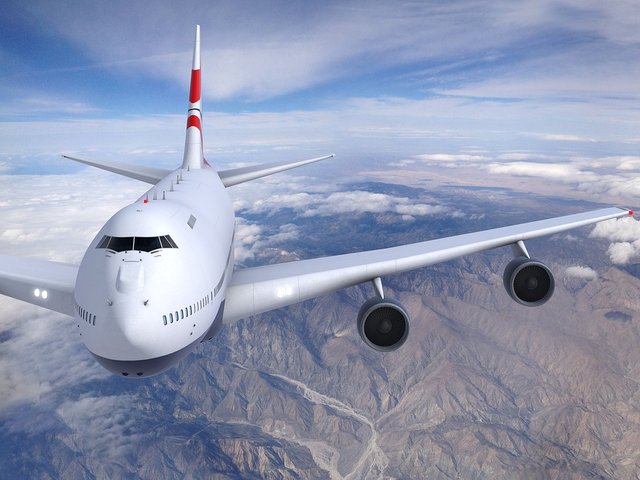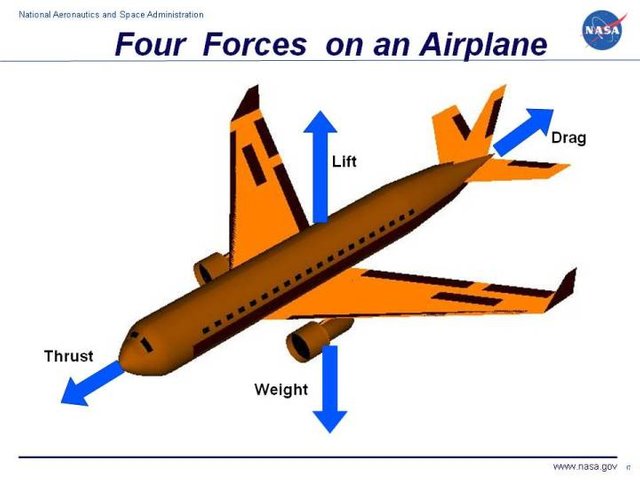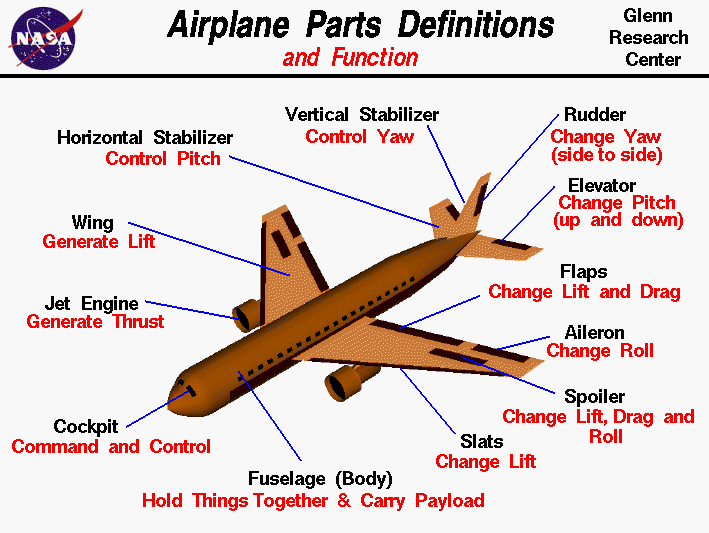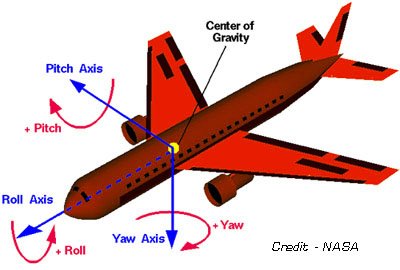
Image source
We all at some point must have looked up in the skies to see how an airplane looks when flying. For those of us who have boarded an aircraft before can give us a better explanation of how it feels to be on board when a plane takes off. Before moving on to the major components that make-up an airplane and how they react with each other, i will be taking us through the forces acting on an airplane while it is in the air. There are four major forces acting on an airplane while it is in the air namely.

Image source
(2) Weight: This acts downward from the center of gravity.
(3) Lift: This acts perpendicular to the airplane and pointing upwards. This acts in opposite direction to the gravity acting on the airplane.
(4) Drag: This is the resistance force pulling the plane backwards and acting opposite in direction to the motion of the plane.
Here is a brief explanation of the parts that make-up an airplane and how they interact with each other to produce the desired outcome which in our own case is flight.
Major components that make-up an airplane.

Image source
(2) The Empennage: This is the part of an aircraft also known as the tail or the tail assembly of the aircraft. It is also similar to the tail of an arrow. The work of the empennage is to provide stability of the airplane during flight.
(3) The Landing Gears: It is the undercarriage of an airplane and can be used for either takeoff or landing. They may come in diverse forms e.g. static or retractable gear system.
(4) The wings: The wings is the part of an airplane that generates lift for the airplane as it thrusts forward and gathers momentum. In modern airliners, the wing also serve as a housing system to the engines of the airplane.
(5) The Powerplants: This is the heart of the airplane as no aircraft can takeoff without this integral component. Smaller aircrafts such as electric rotor aircrafts and drones make use of electrical turbine engines which makes use of electricity. While bigger aircrafts such as fighter jets and commercial airliners make use of jet engines. The powerplants of a commercial airliner generates thrust for the airplane which is then converted to lift by the wings of the airplane. An additional power unit known as the APU (Auxiliary Power Unit) is usually installed at the rear of commercial airliners. It's sole purpose is to provide compressed air to the jet engines of the airplane so as to cause them to accelerate at high rotating speeds. The APU supplies power to the other powerplants.
(6) The Control Surfaces: The control of surfaces an airplane consists of flaps on the wings, ailerons, elevators and rudder. These helps the pilot to tilt the plane about certain axis so as to alter the direction of the plane to a desired direction.
(7) The Avionics Control Systems: The avionics control system includes all the flight control input systems on the flight deck which encompasses all electronic instrumentation systems covering autopilot, navigation systems, collision-avoidance systems, communication systems, flight recorders,etc.
How they interact with each other
They mode of operation for an airplane is not as difficult or complicated as you think. The avionics control system of the airplane is used to switch on the APU which in turn powers on the other two jet engines into accelerating rotational speed so as to produce thrust which pushes the airplane forward and causes it to gather momentum to takeoff. An airplane is just one out of the categories (air and space vehicles, submarines) of vehicles that operates in three dimensions. When we say about 3-dimensions, we talk about 3-dimensional cartesian plane if we pen it down to paper. This is illustrated in the photo below.

Image source
The center of gravity of the airplane is the point where the airplane balances both laterally and longitudinally. The work of the control surfaces is to rotates the airplane about these axises at he right angle to put the plane in the right direction. The aileron rotates the plane about the roll-axis, the rudder rotates the plane about the yaw-axis, while the elevator rotates the plane about the pitch-axis. Elevating too high about the pitch axis could cause the airplane to toll as the angle of attack will be too great for the airplane to handle. So every aspect of the airplane controls system as to be engineered to work just right. The flaps on the other hand is used for reducing the speed of the airplane by increasing the resistance force (drag) on the wings of the airplane in the case of landing the airplane. Landing can be said to be a controlled crash as the engine of the airplane gently shuts down and the flaps increases the drag on the wing while the landing gears are released so as to slow down the speed of the airplane as it hits the runway.
References
(1) https://www.grc.nasa.gov/www/k-12/airplane/forces.html
(2) https://en.wikipedia.org/wiki/Flight_control_surfaces
(3) https://en.wikipedia.org/wiki/Aircraft_engine
(4) http://www.hooked-on-rc-airplanes.com/flight-control-surfaces.html
(5) https://en.wikipedia.org/wiki/Avionics
Hey @gabbythegenius, flight dynamics aficionado here! You did mention the four forces during a flight but it would be more interesting to know how the lift and drag forces are generated by the wings. Since the post is about flight dynamics, the section regarding the parts of an aeroplane doesn't suit that much.
I see you are already in the steemSTEM discord channel, feel free to DM me if you need any help. :)
Downvoting a post can decrease pending rewards and make it less visible. Common reasons:
Submit
Congratulations @gabbythegenius! You have received a personal award!
Click on the badge to view your Board of Honor.
Downvoting a post can decrease pending rewards and make it less visible. Common reasons:
Submit
Congratulations @gabbythegenius! You received a personal award!
You can view your badges on your Steem Board and compare to others on the Steem Ranking
Vote for @Steemitboard as a witness to get one more award and increased upvotes!
Downvoting a post can decrease pending rewards and make it less visible. Common reasons:
Submit